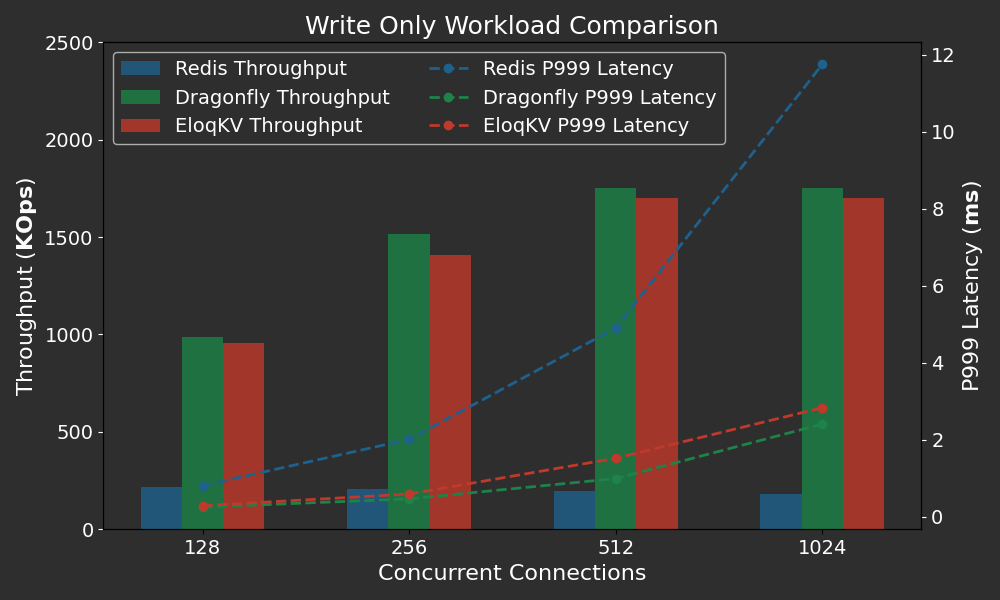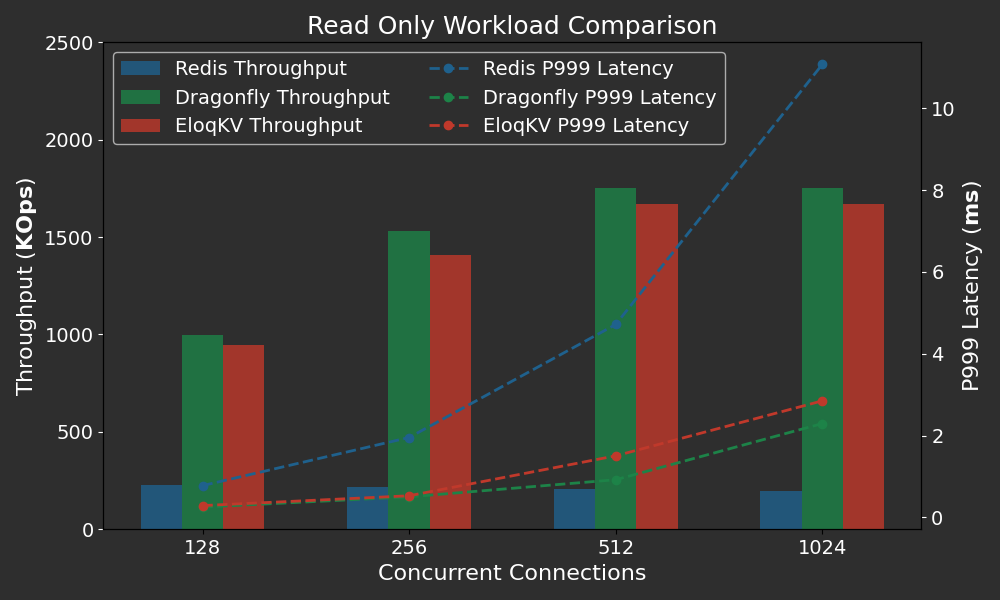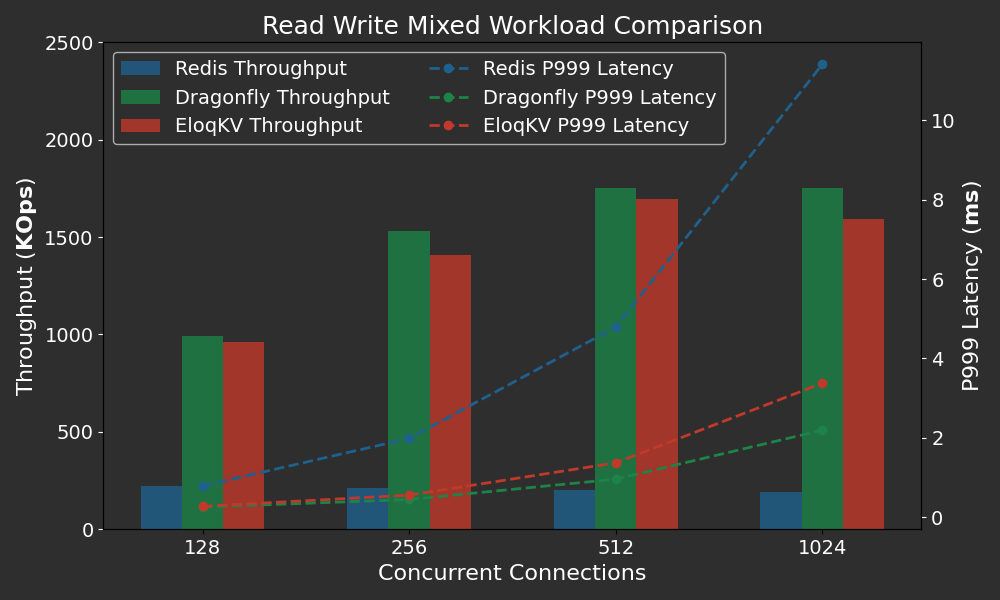In this blog, we evaluate EloqKV as an in-memory cache, focusing on its single-node performance. We compare EloqKV with Redis, a widely used in-memory data store, and DragonflyDB, a newer option boasting high performance due to its multi-threaded architecture and optimized implementation leveraging modern innovations.
All benchmarks were conducted on AWS (region: us-east-1) EC2 instances with Ubuntu 22.04. The memtier-benchmark tool was used to generate workloads.
Single Node Performance
We compare EloqKV with Redis and DragonflyDB in memory-only mode, without enabling persistent storage or transactional features. Both Redis and DragonflyDB have limited persistency capabilities. Redis offers logging (AOF) and checkpointing (RDB), but AOF is rarely configured to fsync on every write due to performance issues. RDB only periodically saves in-memory state, which may cause data loss if a node crashes. DragonflyDB supports only checkpointing, not AOF. Since Redis and DragonflyDB are typically used as in-memory caches, we benchmarked EloqKV in the same configuration.
Hardware and Software Configurations
Server Machine:
| Service | Node type | Node count |
|---|---|---|
| Redis 7.2.5 | c7g.8xlarge | 1 |
| DragonflyDB 1.21.2 | c7g.8xlarge | 1 |
| EloqKV 0.7.4 | c7g.8xlarge | 1 |
| Client - Memtier | c6gn.8xlarge | 1 |
We follow the official instructions to setup EloqKV, DragonflyDB and Redis.
For Redis, we disable AOF and RDB persistency.
redis-server --save "" --appendonly no
For DragonflyDB, we only need to disable checkpointing since it does not yet support logging.
dragonfly --dbfilename=
For EloqKV, we disable persistent storage and turn off WAL (Write-Ahead Logging) in its config.ini file.
# set it to off to turn off persistent storage
enable_data_store=off
# set it to off to turn off WAL
enable_wal=off
Write-Only Workload
To evaluate EloqKV’s write performance, we run memtier_benchmark with ratio of 1:0 (write-only) with the following configuration:
memtier_benchmark -t $thread_num -c $client_num -s $server_ip -p $server_port --distinct-client-seed --ratio=1:0 --key-prefix="kv_" --key-minimum=1 --key-maximum=5000000 --random-data --data-size=128 --hide-histogram --test-time=300
-t: Number of threads, which was set to a fixed value of 32.-c: Number of clients per thread. We configured it to 4, 8, 16 and 32 to evaluate different concurrency levels. This resulted in total concurrency of 128, 256, 512 and 1024, calculated asthread_num × client_num.--ratio: Set:Get ratio, 1:0 for write-only workload.
Results
Below are the results of the write-only workload.
X-axis: Represents the varying concurrencies (thread_num × client_num), simulating different levels of concurrent database access.
Left Y-axis: Throughput in QPS (Queries Per Second).
Right Y-axis: 99.9 Percentile latency in milli seconds (ms).

EloqKV and DragonflyDB both outperform Redis due to their support for multiple worker threads. EloqKV delivers almost the same high throughput and low latency as DragonflyDB across various concurrency scenarios.
Read-Only Workload
For the read-only workload, we adjusted the Set:Get ratio to 0:1 (read-only):
memtier_benchmark -t $thread_num -c $client_num -s $server_ip -p $server_port --distinct-client-seed --ratio=0:1 --key-prefix="kv_" --key-minimum=1 --key-maximum=5000000 --random-data --data-size=128 --hide-histogram --test-time=300
--ratio: Set to 0:1 for read-only operations.
Results

Again, EloqKV offers slightly lower throughput, and slightly higher but still very respectable latency compared to DragonflyDB. Both EloqKV and DragonflyDB significantly outperform Redis, both in throughput and in latency.
Mixed Write-Read Workload
Finally, the mixed workload with a 1:10 ratio of Put:Get:
memtier_benchmark -t $thread_num -c $client_num -s $server_ip -p $server_port --distinct-client-seed --ratio=1:10 --key-prefix="kv_" --key-minimum=1 --key-maximum=5000000 --random-data --data-size=128 --hide-histogram --test-time=300
--ratio: Set to 1:10 for mixed write-read operations.

EloqKV exhibits similar throughput to DragonflyDB. As concurrency increases, EloqKV shows a slightly higher P999 latency than DragonflyDB, but remains under 4ms even with over a thousand concurrent connections.
Analysis and Conclusion
Based on the previous experiments, we can obtain some interesting observations. In this section, we will give some (opinionated) analysis.
Single Worker vs Multiple Workers
EloqKV and DragonflyDB can significantly outperform single process Redis on a modern multi-core server. The difference is the result of a fundamental design philosophy took by Redis. Redis restricts internal in-memory data structure operations to a single worker thread, while multiple IO threads handle networking and persistency. This choice, though greatly simplifies Redis's design, naturally limits performance on multi-core systems. In comparison both EloqKV and DragonflyDB allow multiple workers.
There is plenty of debate about whether the performance comparison is fair. Redis is supposed to scale horizontally even on a single server node, by being deployed as a cluster with multiple instances/shards. Even for single worker architecture, there is still space for optimization, as demonstrated by Valkey, which has been pushing the performance of Redis-like KV store.
Nonetheless, with increasing CPU cores and more complex query workloads, we believe that single threaded designs face fundamental limitations. Even Redis is exploring multithreading for certain queries. A Redis cluster behaves differently from a single server, requiring special care for key partitioning and load balancing. We will discuss clustering in the next blog post.
Do We Really Need to Specialize?
Compared with DragonflyDB, EloqKV currently lacks a few optimizations such as io_uring based networking. Due to these limitations, our profiling shows that EloqKV is bounded by the networking stack when serving the workloads in the experiments.
Even so, as the experiments demonstrated, EloqKV works almost as well as DragonflyDB on a workload that DragonflyDB was specifically designed and optimized for. This begs the question of whether designing special database software for limited use cases is profitable. Unlike Redis and DragonflyDB, EloqKV is much more than a single node memory cache. It excels in clustered, durable, and fully ACID-compliant transactional setups. Future blog posts will explore these capabilities in greater detail.
EloqKV is based on our Data Substrate technology. We believe that with this revolutionary technology, users can greatly simplify their data infrastructures by reducing the need for many specialized databases.
